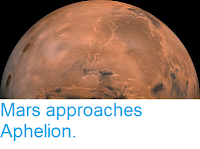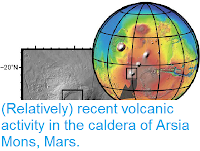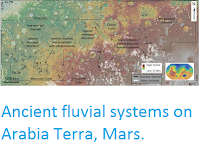The planet Mars will reach opposition (i.e. be directly opposite the
Sun seen from Earth) at 7.50 am GMT on Friday 27 July 2018, when it will also be at its closest point to the Earth since 2003 (when it made its closest approach in about 60 000 years). Mars will reach a closest point of about 70 800 000 km from us (47% of the average distance between the Earth and the Sun, or 184 times the distance between the Earth and the Moon), and completely illuminated by the Sun.
The relative positions of Earth and Mars for the next 13 Years. Oppositions occur roughly once every two years. D Jenkins/Astra's Stargate.
While the relative positions of the planets have no direct influence on
life on Earth, the opposition of Mars does present the best
opportunity for observations of the planet by Earth-based observers. Mars orbits the Sun at an average distance of 1.52 AU, completing one
orbit around the Sun every 687 days. This means that it
reaches Solar Opposition roughly once every two year, and reaches conjunction (when it is directly behind the Sun
seen from the Earth), in the intervening years.
See also...
See also...
Follow Sciency Thoughts on Facebook.







